Ben Hodges, Steven Horrell and Ivanna Kuz
Introduction
 The Black Sea Region (BSR) is an area of critical geostrategic importance. It is Eastern Europe’s gateway to the Mediterranean and to global sea lines of communication. It links Europe to the Caucasus and the Middle East. The region is a key node of the global energy economy, both for hydrocarbon resources in the region and for transit infrastructure. Today, it is the site of a large-scale conventional war, the most destructive in Europe since World War II.
The Black Sea Region (BSR) is an area of critical geostrategic importance. It is Eastern Europe’s gateway to the Mediterranean and to global sea lines of communication. It links Europe to the Caucasus and the Middle East. The region is a key node of the global energy economy, both for hydrocarbon resources in the region and for transit infrastructure. Today, it is the site of a large-scale conventional war, the most destructive in Europe since World War II.Russia’s war on Ukraine is the culmination of Moscow’s steadily increasing militarization of the Black Sea Region, which has a prominent place in the Kremlin’s strategic worldview due to cultural and historical factors.
The United States and NATO – even though NATO members Turkey, Bulgaria, and Romania are Black Sea littoral states – have previously lagged in providing a strategic perspective on the region. This war gives the US and NATO even more reason to develop coherent and action-based strategies to check Russia’s unabashed aggression and to ensure the security of the Black Sea Region. The 2022 NATO Madrid Summit emphasized the Black Sea Region with several key decisions, 2 and the US Congress is considering legislation to enhance security in the BSR. 3
Before focusing on Russia’s militarization of the region and its implications for the West, this study opens with a brief look at Russia’s strategy and the importance of the Black Sea in it. For Russia, the geostrategic importance of the Black Sea Region is magnified by cultural and historical ties and the prominent place of “near-abroad” states in Russia’s security perceptions. Russia’s national identity myths look back to Kyiv, and tsarist Russia sought warm-water ports on the Black Sea for centuries to overcome the limitations of its frozen northern geography. Former Soviet Socialist Republics like Ukraine and Georgia are still desired as pliant buffer states.
The Black Sea Region is a focal point of several of Russian President Vladimir Putin’s strategic aspirations. In Russia’s view of the international order, the “near abroad” represents a geographic buffer to ensure the security of Russia itself. 4 “From the Kremlin’s perspective, the BSR is part of a coherent western flank.” 5 Putin has also clearly stated his desire to reclaim dominance over former Soviet lands. 6 Furthermore, creating a Russian sphere of influence against the West and the US – and staking out a middle ground between the West and a China rising in geopolitics and trade – fits the Kremlin worldview of multipolarity, and conviction of Russia’s rightful role as one of the great power poles.
That strategic view shaped Russia’s militarization of the region from the post-Cold War nadir. The Southern Military District and the Black Sea Fleet increased their military capabilities in both quantity and quality. This study will look briefly at some aspects of hybrid capabilities in the region such as the use of private military contractors (PMCs), as well as cyber and electronic warfare. This militarization accelerated following the illegal annexation of Crimea in 2014, the invasion of the Donetsk and Luhansk regions of Ukraine, and ultimately the full-scale invasion of Ukraine in February 2022.
Recognizing that Russia’s war on Ukraine is ongoing, this study nonetheless aims to project the impact of the conflict on Russia’s strategic perception of the region and post-conflict military posture before examining the implications for NATO and the US.
Russia's Strategic View of the Black Sea Region
Russia’s strategy is global in nature, espousing a vision of world power status and Russian leadership of a Eurasian pole that competes as a peer with the Euro-Atlantic and China. In practice, Russia’s foreign policy implementation and security actions on the world stage give an outsized importance to the Black Sea Region. Russia is interested in a BSR that is secure from excessive US/Western interference which would directly impact Russia’s own borders. Its historical ties to countries in the region like Ukraine, Georgia, and Moldova place them — in the Kremlin’s view — rightfully in Russia’s “sphere of influence.” Moscow views any moves by these countries into a Euro-Atlantic alignment, rather than a Eurasian one, as a direct threat to Russia’s national interests. The Black Sea Region, and its ability to connect Russia to the Eastern Mediterranean and the Middle East, is critical to Moscow’s views of national security. 7
The Russian Federation’s National Security Strategy of December 2015 8 defines Russia’s national interests as:Strengthening the country's defense, ensuring the inviolability of the Russian Federation's constitutional order, sovereignty, independence, and national and territorial integrity;
Strengthening national accord, political and social stability, developing democratic institutions, and refining the mechanisms for cooperation between the state and civil society;
Raising living standards, improving the population's health, and ensuring the country's stable demographic development;
Preserving and developing culture and traditional Russian spiritual and moral values; increasing the competitiveness of the national economy;
Consolidating the Russian Federation's status as a leading world power, whose actions are aimed at maintaining strategic stability and mutually beneficial partnerships in a polycentric world.
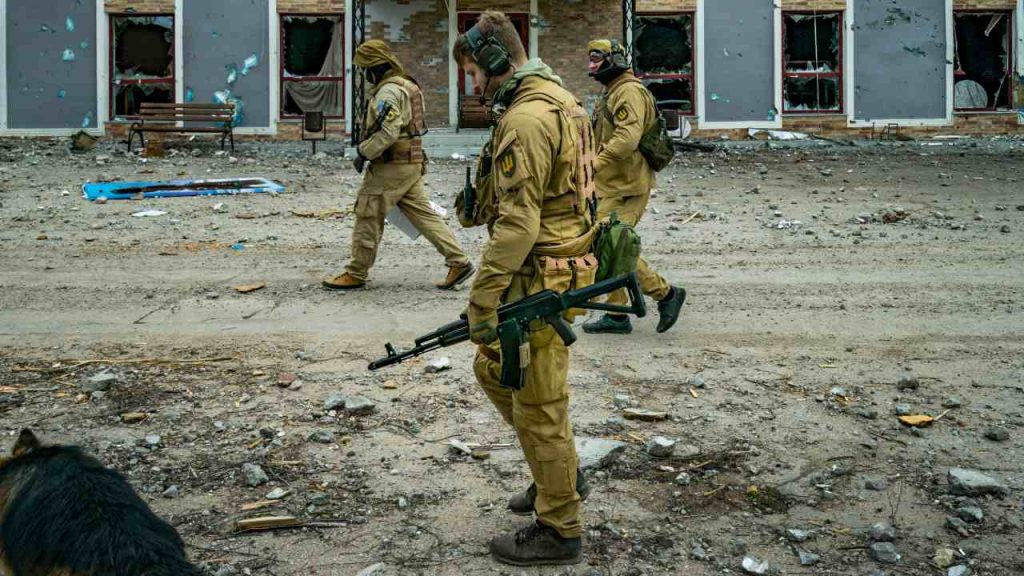 Photo: Ukrainian soldiers patrol on the frontline of Mykolaiv surrounded by the destruction after the Russian shelling of a village, Ukraine. Credit: Photo by Celestino Arce/NurPhoto.
Photo: Ukrainian soldiers patrol on the frontline of Mykolaiv surrounded by the destruction after the Russian shelling of a village, Ukraine. Credit: Photo by Celestino Arce/NurPhoto.The recent revival of the concept of Novorossiya adds to this expansive perception. Historically, these are territories now in the south of Ukraine, along the northern Black Sea from Luhansk and Donetsk to Odesa, which Russia controlled in the eighteenth century. 9 The concept of Novorossiya has sometimes been expanded to include Bessarabia (west of Odesa) and parts of modern-day Moldova. The Russian-led separatists in the self-proclaimed Donetsk and Luhansk People’s Republics invoked Novorossiya, including use of its historic flag. 10 More recently, on June 9, 2022, Putin referred to returning “historic Russian lands,” which is his way of “justifying” the war in Ukraine. He conveyed other threats or ambitions by mentioning the Lithuanian city of Narva and comparing himself to Peter the Great. 11 Putin’s concept of Russian lands leads to Russian statements of self-defense inclusive of its entire perceived Eurasian sphere of influence. The Black Sea Region is central to this conflation.
In a similar fashion, the fourth of the national strategy’s stated national interests – preserving Russian culture and spiritual and moral values – is amplified in the Black Sea region. Kremlin rhetoric in the regional frozen conflicts and in Ukraine has been about protecting the Russian people. While there are certainly cultural and historic ties, this was carried to an ahistorical extreme in Putin’s July 2021 essay “On the Historical Unity of Russians and Ukrainians.” 12 The frozen conflicts in the region are strategically significant for Russia in relation to two expanded national interests: Russian lands and Russian peoples. These conflicts allow Russia to keep toeholds on its Eurasian “sphere of influence” and prevent the countries involved from aligning with the West. In each frozen conflict, Transnistria in Moldova, Abkhazia and South Ossetia in Georgia, and Nagorno-Karabakh contested between Armenia and Azerbaijan, Russia plays a different role.
Moscow’s political, military, and financial assistance since 2008 has grown central to the way in which both Abkhazia and South Ossetia function. Russia and its economy serve as financial lifeline to both breakaway regions, but not an entirely reliable one. Moscow is reluctant to increase its investment since complete integration of the breakaway regions would require substantial involvement in the governance and administration of both Abkhazia and South Ossetia. 13 Instead, Russia conveniently maintains presence and control with the aim to destabilize Georgia and threaten its path to Euro-Atlantic integration. Both Abkhazia and South Ossetia are clearly significant for Russia’s interests given that its 2015 National Security Strategy states that developing bilateral and multilateral cooperation with both regions is a key area of foreign policy for Moscow. 14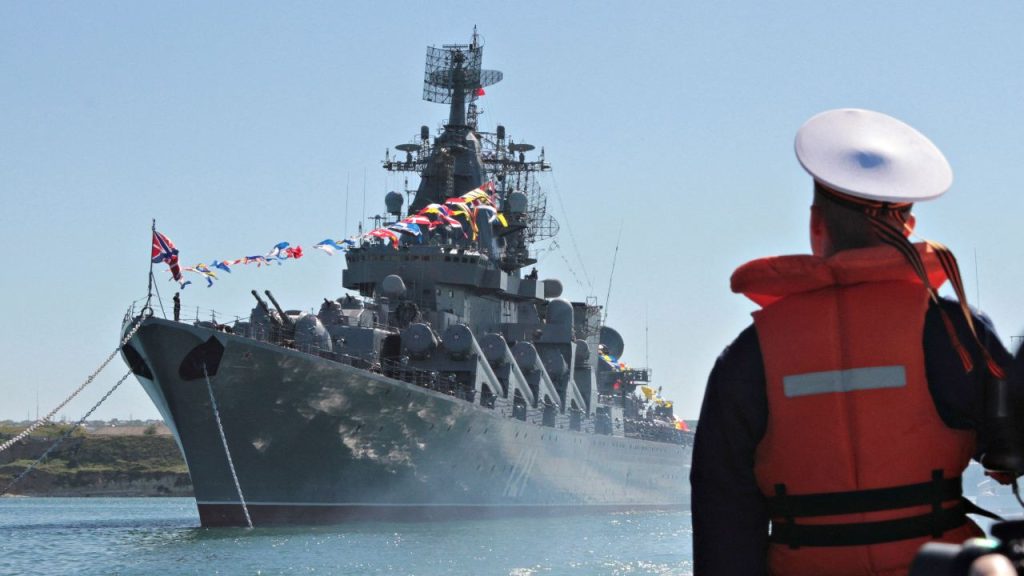 Photo: A sailor looks at the Russian missile cruiser Moskva moored in the Ukrainian Black Sea port of Sevastopol, Ukraine 10, 2013. Credit: REUTERS/Stringer/File Photo.
Photo: A sailor looks at the Russian missile cruiser Moskva moored in the Ukrainian Black Sea port of Sevastopol, Ukraine 10, 2013. Credit: REUTERS/Stringer/File Photo.
 Photo: A sailor looks at the Russian missile cruiser Moskva moored in the Ukrainian Black Sea port of Sevastopol, Ukraine 10, 2013. Credit: REUTERS/Stringer/File Photo.
Photo: A sailor looks at the Russian missile cruiser Moskva moored in the Ukrainian Black Sea port of Sevastopol, Ukraine 10, 2013. Credit: REUTERS/Stringer/File Photo.In the case of Nagorno-Karabakh, the most volatile of the frozen conflicts with a recent outbreak of fighting in September 2020, Moscow is interested in maintaining its role as the leader in shaping and influencing what happens on the ground. Russia’s approach to Nagorno-Karabakh has always incorporated a historical lens that dates back to imperial times. 15 Moscow created its own niche approach to the resolution of the Nagorno-Karabakh conflict, and views it as a key component of Russia’s southern security. 16 During the 2020 war between Armenia and Azerbaijan, Russia introduced its “peacekeepers” to exert control over the shifting status quo. Russia’s maneuvering in Nagorno-Karabakh, seeking leadership while outflanking competitors like Turkey and the EU, mirrors actions in Ukraine going back to 2014 and even prior to 2014.
In Transnistria, arguably the least volatile of the frozen conflicts in the region, the Kremlin has maintained a foothold since the early 1990s. Its provisions of financial support and stationing of forces makes Transnistria highly dependent on the Kremlin for survival. Moscow ensures this dependence to fulfil its political intent to keep Moldova in its “sphere of influence” and project its power in the region. 17 Additionally, Transnistria plays an important role in Moscow’s strategic goals in the war in Ukraine. According to Russian military officials, Russia wants to establish full control over southern Ukraine to secure a gateway to Transnistria. 18 Geographically, Moscow’s ambitions to create a land bridge to Transnistria are part of its larger goal to establish a greater presence in and control over the Black Sea. 18
The Black Sea remains crucial to Russia because it provides easy connectivity to other regions of vital interests to Moscow. Russia’s interest in Black Sea warm water ports dates to the Romanov tsars and the original Russian acquisition of Crimea. 19 Today, the Black Sea is a springboard for Russia’s operations in Africa and the Middle East, where Moscow remains interested in maintaining a foothold and exerting influence. In 2013, Russia reestablished a permanent naval presence in the Mediterranean Sea with its Mediterranean Squadron. The Black Sea Fleet (BSF) has been the primary supplier of ships and logistics for the squadron. 20 While this naval presence, which has continued to the present day, depends on other fleets’ contributions of warships above and beyond the Black Sea Fleet’s capacity, it is commanded and controlled by the BSF.
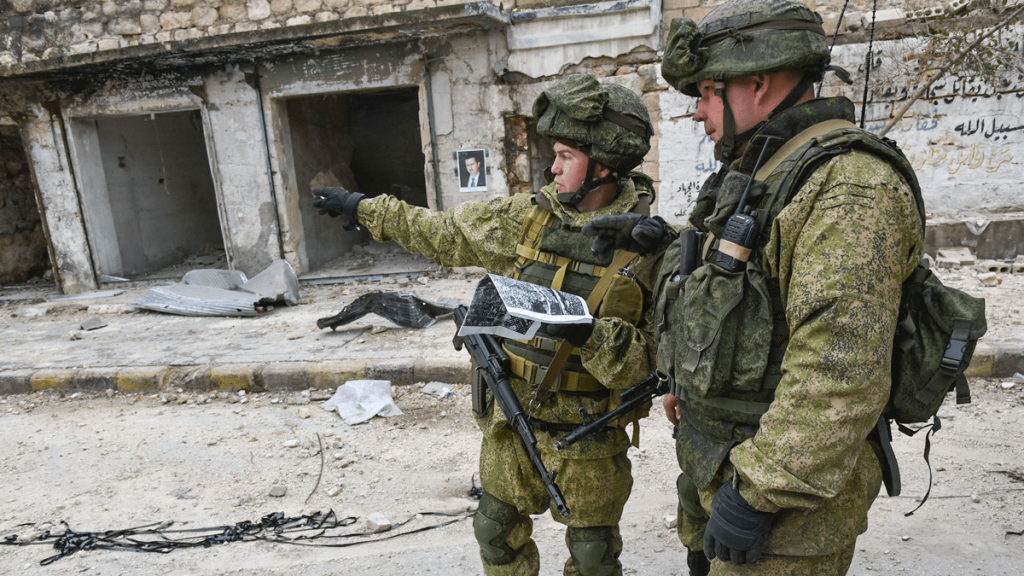 Image: International Mine Action Center of the Russian Ministry of Defense in Aleppo, Syria. Credit: Ministry of Defence of the Russian Federation.
Image: International Mine Action Center of the Russian Ministry of Defense in Aleppo, Syria. Credit: Ministry of Defence of the Russian Federation.Russia has used the Black Sea to achieve its strategic aims and military operations in Libya and across Africa. Despite its rapidly deteriorating economy and the military failures in Ukraine, Russia remains committed to preserving its influence in Libya and Sudan, for example. 21 Russia is likely to continue its presence in Libya, maintaining control of some of the camps, army bases, and air bases in the country as well as its clandestine operations there. 21 While Moscow may seek to readjust its mission in Libya, especially vis-à-vis its Wagner Group presence in the context of its war in Ukraine, it is likely that Russia will not pull most of the mercenaries out of Libya. While the Kremlin needs reinforcements in Ukraine, it also wants to have a stake in Libya’s future. Keeping foreign mercenaries there is one way to keep a hold on the country. 22 Wagner Group operatives continue to play a significant role in Libya. They are responsible for placing banned antipersonnel landmines, including victim-activated improvised explosive devices (IEDs) and booby traps in Libya’s city of Tripoli, killing and maiming hundreds of civilians.
At the same time, Russia has demonstrated a strategic focus on developing a political, economic, and military influence on the rest of Africa since its illegal annexation of Crimea in 2014. 23 The Russian forces maintain a presence in Mali, although Moscow claims that it has only sent military instructors to the country. 24 The Wagner operatives on the ground have evident links to Mali’s military, which has committed mass killings of civilians. 25 Russian foreign fighters, namely the Wagner Group, have been operational in Mali since December 2021, causing a refugee crisis. 26 Aiming to exploit existing vacuums and gain a stronger foothold in Africa, Russia is also suspected of helping with a coup attempt just across the border in Burkina Faso. 27 Many in Burkina Faso, admiring Russia’s intervention in the Central African Republic (CAR), where Russian mercenaries fought off an Islamist offensive last year, see the Russians as capable of fixing the troubles in their country. 28
Moscow also views the Black Sea as a gateway to the Caucasus – both an enduring interest for Moscow and a perceived threat vector for instability – and the Western Balkans, where Russian influence operations act as a thorn in the side of the US, NATO, and the EU. These influence operations include a fostering of shared cultural ties between Moscow and the respective countries, as well as a deepening of economic and trade relations in the spheres of energy, banking, and real estate, which helps create Russian-friendly local populations. 29
The Black Sea is central to Russian strategic thinking. This importance was a key driver in Russia’s militarization of the region.
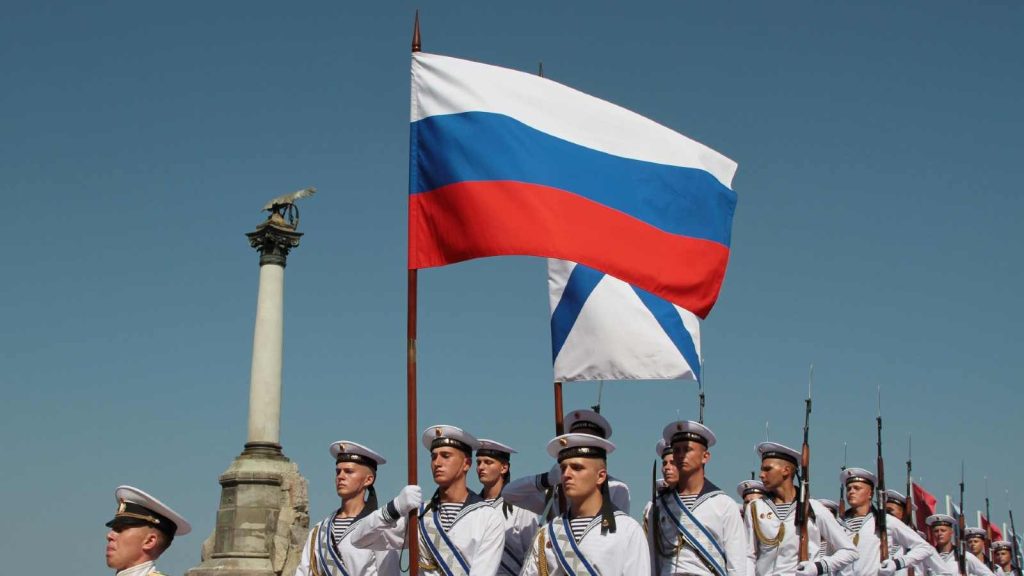 Photo: Russian sailors march during the Navy Day parade in the Black Sea port of Sevastopol, Crimea July 28, 2019. Credit: REUTERS/Alexey Pavlishak
Photo: Russian sailors march during the Navy Day parade in the Black Sea port of Sevastopol, Crimea July 28, 2019. Credit: REUTERS/Alexey PavlishakThe Evolution of Russia's Militarization of the Black Sea Region
For the first two decades after the fall of the Soviet Union, Russia was not well-positioned to act on its strategic aims in the region. The Black Sea Fleet was an exemplar of the decline of the former Soviet military – a shell of its former self, and dependent upon a lease with Ukraine to keep 20% of its ships in Sevastopol. When Putin rose to power, and energy profits filled the Kremlin’s coffers, Russia embarked on rebuilding its conventional military power.
The first major military reforms, beginning under Minister of Defense Anatoly Serdyukov in 2008, sought structural change in the armed forces of the Russian Federation. 30 Military districts (MD) were consolidated, as were the regional Joint Operational Commands (West, South, Center, and East). The restructure and streamlining were accompanied by major reforms of personnel programs to ensure a professional military force. The conscript system was also overhauled to achieve a more professional and officially contracted force. The Serdyukov reforms targeted the establishment of a professional non-commissioned officer corps. 30 Some degree of modernization was achieved, largely by eliminating outdated equipment. For example, the Russian Federation Navy scaled down from 240 to 123 units while improving manning and readiness, and the Air Force decreased from 340 to 180 units.
Following the Serdyukov reforms, and Russia’s 2008 incursion into Georgia – tactically successful in reasserting control of the breakaway regions of Abkhazia and South Ossetia but highlighted many deficiencies in Russia’s capabilities on a modern battlefield – the State Armament Plan for 2011-2020 (SAP 2011-20) 31 focused on modernization. The Southern Military District and the Black Sea Fleet were emphasized in the SAP 2011-20. This modernization directed 25% of the budget to the Navy and 24% to the Air Force (including both aircraft and ground-based air defence). Fifteen percent was allocated to the Land Forces, including the acquisition of 2,300 tanks, 2,000 artillery sets, and 10 Iskander-M brigades (about 200 rockets each). Another 14% of the expenditure was allocated to new communications, command and control, and intelligence systems.
According to the 2011-2020 State Armament Program 31 the land forces received upgraded tanks and artillery systems, including the Iskander-M. Most of the equipment went to units located in the west of the country, mostly in the Western and Southern Military Districts (MD). In 2014, in the Southern MD, four mechanized divisions were created based on existing brigades. Moreover, the strengthening of the Southern MD was related to the Russian military involvement in the war in Donbas and the need to strengthen the military presence in occupied Crimea. It is worth noting that one division (the 42nd) was created in Chechnya, which increases Russian military capabilities in both the North and South Caucasus. The Southern MD received mainly T-72B3 tanks, BMP-3s, and BTR-82As.
The SAP 2011-20 was largely successful in its major modernization of Russia’s armed forces. 32 This is evidenced by operations in the Black Sea, and beyond which demonstrate Russia’s willingness to utilize newly acquired capabilities as strategic requirements dictated. In 2013, to increase support to Putin’s beleaguered ally Syrian President Bashar al-Assad, Russia announced the formation of a permanent naval force in the eastern Mediterranean based out of Tartus.
Focusing conventional Russian militarization on Ukraine intensified after 2014, but the annexation of Crimea and Russian invasion of the Donbas were dependent on hybrid capabilities developed alongside conventional militarization. Chief of the General Staff of the Russian Armed Forces General Valery Gerasimov wrote in February 2013 33 about integrating non-military and military capabilities. 34 The 2014 annexation of Crimea is an excellent example of hybrid warfare, 35 merging non-military means such as local proxies and a robust disinformation campaign with limited employment of military forces to create ambiguity and confusion, and avoid the confrontation of a conventional force-on-force conflict. 34 Even when the “little green men” arrived in Crimea, they had just enough deniability to maintain confusion until the new administration could be installed.
The war in Donetsk and Luhansk from 2014-2022 demonstrated another hybrid warfare aspect of employing irregular and proxy forces alongside conventional militarization. Russia continued to employ this tactic, which was used in the full-scale invasion of Ukraine on February 24, 2022. Fighters from the Wagner Group joined the Russian forces in an offensive in the Donbas region. By March 2022, over 1,000 Wagner group troops had been sent to Ukraine, according to US intelligence. 36 They launched attacks on the city of Popasna fierce enough to remind local officials of those launched in Mariupol. 37 The Armed Forces of Ukraine (AFU) destroyed a local base of the private mercenary group Luhansk Oblast in early June. 36 At least two neo-Nazi groups are fighting for Russian forces in Ukraine (the Russian Imperial Legion and Rusich). 38 Both groups are thought to have participated in the war in Ukraine’s Donbas since 2014, and there has been evidence linking Rusich with Russia’s Wagner Group.
In Donbas, one of the Kremlin’s main goals was to demonstrate its capacity to mobilize the Arab World. 39 Russia’s ally, Syria, has offered its support to Russia in the form of volunteer fighters to whom it offered a volunteer contract from the Military Intelligence Division 217. 39 Although mercenaries from Syria dressed in Russian army uniforms were seen in occupied Melitopol, Zaporizhzhia region, 40 the official claim 41 that 40,000 Syrian mercenaries have registered to fight in Russia has not been confirmed.
Conventional militarization accelerated following the 2014 annexation of Crimea, especially in the area of anti-access and area denial. Russia quickly moved air and coastal defense capabilities to the peninsula. The introduction of its fourth S400 surface-to-air missile battalions in 2018 enhanced the defenses of strategic and operational facilities in Crimea, 42 and extended their air defense coverage to 400 km. For coastal defense, the Bastion system with supersonic 350 km range Onix anti-ship missiles and the 120km subsonic Bal missiles were also moved to Crimea. The coverage of these advanced missile systems, compared to their former positions in Krasnodar, expanded Russian anti-access and area denial from the eastern third of the Black Sea to almost the entire Black Sea airspace and water space. 43
Electronic warfare (EW) also contributed to anti-access area denial capability. The Russians claimed that by 2020, Crimea was equipped with all necessary means of EW to transform the region into what could be roughly translated as an “area denial zone.” 44 As early as 2014, the Black Sea Fleet received its first long-range Murmansk-BN jamming system. 44 Indeed, the entire Black Sea region has been “Putin’s Petri Dish” for EW and cyber. In Donbas, Russian-led forces honed tactical electronic warfare, jamming and spoofing communications, 45 and even targeting and hacking cellular phone usage by Ukrainian forces. Ukraine and Georgia are also frequent targets of Russian cyberattacks. The 2017 NotPetya attack that initially targeted Ukrainian government and commercial sites before spreading globally is one such example. Many expected the Russian full-scale invasion of Ukraine to begin with cyber and EW attacks as the first step. This did not materialize to the extent expected, in part because Ukraine employed an active cyber defense, which benefited from the support of the US and other international actors. However, a new study released by Microsoft 46 illustrates that Russia used its team of hackers to conduct hundreds of subtle attacks, many of which were timed to coincide with missile or ground attacks. According to Microsoft, while “they had some success,” the Russians were met with a robust defense from the Ukrainians that blocked some of the online attacks. Nevertheless, between February 23, 2022, and April 8, Microsoft noted 37 destructive cyberattacks aimed at Ukrainian targets. 47 The report demonstrates Russia’s persistent use of cyberweapons, upending early analysis that suggested they had not played a prominent role in the conflict. The Russian invasion relies in part on a cyber strategy that includes at least three distinct and sometimes coordinated efforts – destructive cyberattacks within Ukraine, network penetration and espionage outside Ukraine, and cyber influence operations targeting people around the world. The Russians, leaving civilian infrastructure largely intact, employed cyber operations against Ukraine’s command and control systems instead. In April 2022, Russia shifted its focus from the north of Ukraine to the Donbas and employed EW more extensively. 48
Russia’s militarization of the Black Sea Region also includes military forces in the “frozen conflict” zones. In addition to providing the strategic leverage noted above, Russia’s presence in these regions provides several military footholds, and allows for reinforcement within the region, as demonstrated in the war on Ukraine. Approximately 1,000-1,500 Russian troops remain in Transnistria. In Georgia, 10,000 Russian troops are in South Ossetia and 3,500 in Abkhazia. Russia maintains 1,960 of its peacekeepers in Nagorno-Karabakh. 49
Implications and Recommendations for NATO
NATO's Strategic Environment
NATO’s strategic view of the Black Sea region begins by necessity with the three members that are Black Sea littoral states: Turkey, Romania, and Bulgaria. The three allies offer differing perspectives on regional security.
Turkey has been a NATO member since 1952, and for seven decades has acted as the Alliance’s southeastern bulwark. Its large and capable armed forces have been a key contributor to NATO’s deterrence and collective self-defense in the Cold War years and since. Turkey’s geostrategic position astride the entrance to the Black Sea, and the size and strength of its armed forces of relative to Romania and Bulgaria, lend Ankara a natural leadership position among the three.
Turkey’s conception of Black Sea regional security has long been centered on the Black Sea nations providing this security, rather than a larger NATO effort. Turkey was strongly committed to previous regional security structures, such as Black Sea Force, Black Sea Harmony, and the Organization of Black Sea Economic Cooperation (BSEC). The inclusion of Russia in those efforts was crucial at their formation but renders them ineffective in the present situation.
Another key element of Turkey’s perception of and contribution to Black Sea regional security has been its continued implementation of the Montreux Convention. Ankara’s invocation of Article 19 of the convention was one of the first international measures taken denoting the February 24 invasion of Ukraine as a war. Denying Russian warships transit of the straits was an important step, but it has not alleviated the effective blockade of Ukraine’s Black Sea coast.
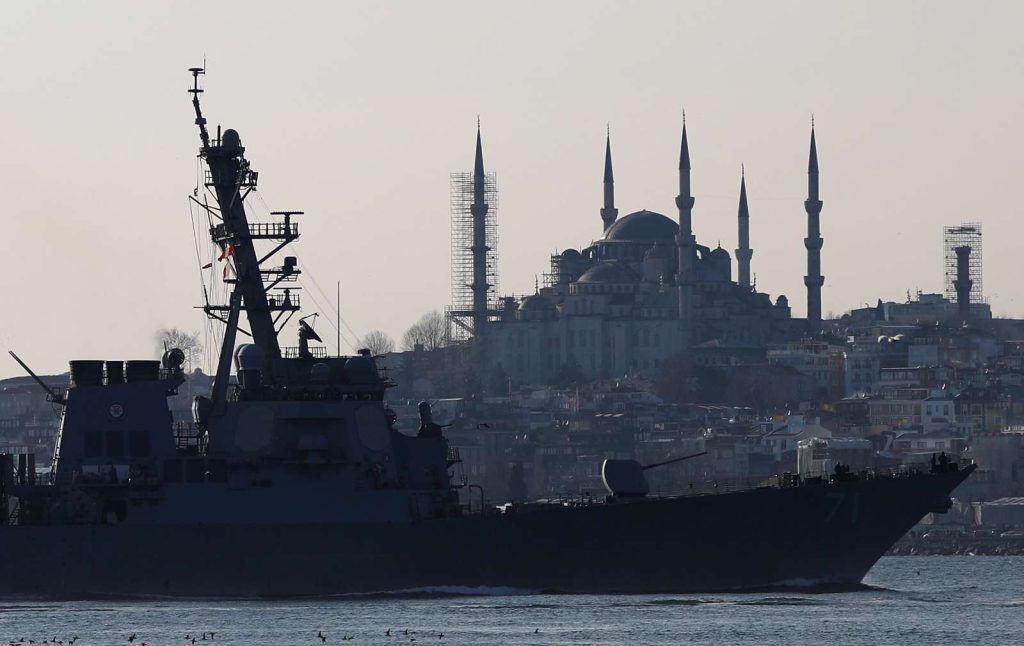 Photo: US Navy guided-missile destroyer USS Ross, with the Blue Mosque in the background, sails in the Bosphorus, on its way to the Black Sea, in Istanbul, Turkey, February 23, 2020. Credit: REUTERS/Murad Sezer
Photo: US Navy guided-missile destroyer USS Ross, with the Blue Mosque in the background, sails in the Bosphorus, on its way to the Black Sea, in Istanbul, Turkey, February 23, 2020. Credit: REUTERS/Murad SezerAt the same time, Turkey has charted its own course for Black Sea security and its own national interests, exemplified by its decision to purchase S400 air defense systems from Russia, which led the US to cancel Turkey’s participation in the F-35 program. Following the 2022 Madrid Summit, US President Joseph R. Biden announced that the US will provide Turkey with F-16s and F-16 modernization, smoothing over this disagreement. 50 The Madrid Summit also saw the groundbreaking agreement for Turkey to forestall its disagreement on the approval of Finland and Sweden’s applications to join the Alliance. On balance, the Madrid outcomes highlight Turkey’s importance to NATO and the consideration of Ankara’s national security concerns, but at the same time keep a spotlight on Turkey’s balancing act and unique perspective on Black Sea regional security.
Romania is outspoken about increasing NATO’s role in Black Sea regional security. It is ambitious about playing a regional leadership role but is not yet well positioned to do so. Recent legislation increased Romanian defense spending to 2.5% of its gross domestic product (GDP), well above the NATO target. 51 Romania hosts the Multi-National Division Southeast, and NATO’s use of bases like Mihail Kogalniceanu and Campia Turzii is key to the Alliance’s ability to position forces in the region. Romania has played a role in building the capacity of Moldova, Georgia, and Ukraine. It has also welcomed Ukrainian refugees. However, Romania still has small armed forces with limited naval capabilities. Further, political dynamics have left several major acquisitions programs stalled.
Bulgaria is committed to NATO and to Euro-Atlantic integration more broadly. However, it has not proven to be proactive in leading NATO efforts within the region. Bulgaria’s defense spending is estimated at 1.56% of GDP, but that spending, and any future increased defense spending to reach the NATO goal of 2% is largely absorbed in efforts to modernize former Warsaw Pact equipment. 52 Meanwhile, Bulgaria’s limited response to the Russia-Ukraine war has reflected the political turbulence within the country, 53 with three parliamentary elections in 2021 alone. Russia has also successfully executed “elite capture” within Bulgaria in the decades since the end of the Cold War. 54 There is a lingering mistrust of the United States in some sectors of society as well.
Finding common ground for shared regional leadership between Turkey, Romania, and Bulgaria will be critical to successfully implementing a NATO security strategy for the Black Sea region.
Military Mobility
When examining the strategic and operational environment for NATO in the Black Sea region, military mobility is a critical requirement. As discussed at length in CEPA’s Military Mobility Study 55 this is a key enabler for increased force deployments to the region and credible deterrence. The Alliance must be able to respond to multiple threats from several regions and directions at short notice and deliver the right forces at the right place and time.
The core principle of military mobility is to move combat forces and their weapons efficiently toward their objective, and for combat support and combat service support forces to maintain the fighting efficiency of the force once it is engaged. Military mobility is only a credible contributor to deterrence if the infrastructure and the enabling systems are robust, the network has adequate redundancy, and infrastructure and permissions are in place. While NATO’s members provide extensive military power when compared to Russia, they are highly disaggregated when it comes to geography, command, and structure, as well as different types of strategic cultures. Strengthening of military mobility requires extensive and regular high-level and staff-level consultations between NATO and EU member countries.
Military Mobility Recommendations for the Reinforcement of Bulgaria and Romania
In light of Russian militarization in the Black Sea Region and the full-scale invasion of Ukraine, reinforcing NATO’s southeastern region, especially vis-à-vis Bulgaria and Romania for military transport to the Focşani Gate, has become even more significant than before. The needs are evident across the board.
First, Romania needs major improvements to its air, road, river, and rail infrastructure. Its road infrastructure is unsuitable at present for large deployments of forces due to narrow roads, weak bridges that would not support large and heavy vehicles, and narrow tunnels that pose their own inconveniences. There are also several river crossings in Romania where bridges cannot support armor (the Focșani and Galați bridges are the exception).
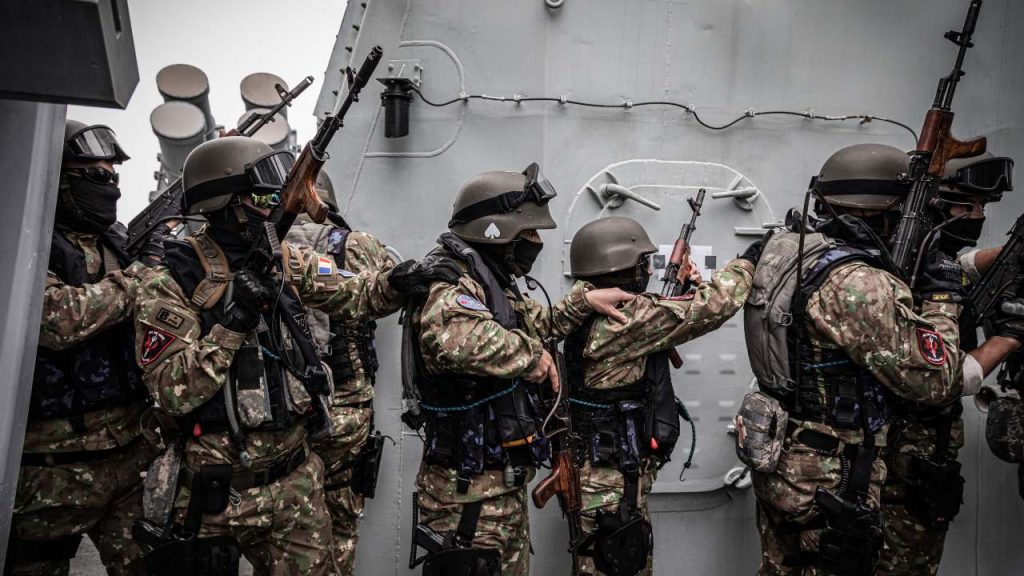 Photo: Romanian Special Operations Forces execute a simulated boarding operation aboard the Canadian frigate HMCS Toronto during Exercise Sea Breeze 2019. Credit: NATO
Photo: Romanian Special Operations Forces execute a simulated boarding operation aboard the Canadian frigate HMCS Toronto during Exercise Sea Breeze 2019. Credit: NATONeighboring ally Bulgaria is in dire need of a comprehensive assessment of critical intermodal choke points and vulnerabilities. This process would require a detailed and in-depth series of onsite measurements and route analysis to assess the reliability of railways in the country. Romania would need such analysis as well, but Bulgaria’s multiple problems associated with electricity supply and the type of voltage used by its railways make this a particular necessity. There is an overarching need to standardize railways across the region.
Given these constraints and vulnerabilities, special attention should be paid to create and consider innovative and secure transportation routes. As an example, the Poland-Ukraine(Lviv)-Romania route would probably be the most secure option prior to any fighting in Romania, while the Greece-Bulgaria-Romania route would probably be the only viable land route once a conflict had already broken out. In all, when anticipating risks to security, the key factors to consider include: a big-picture approach to scenario planning, anticipation and understanding possible civil unrest, and airborne fire support platforms (i.e. attack helicopters, US Army aviation).
Military Mobility Recommendations for the Danube River
For reinforcement of NATO’s southeastern region, utilizing the Danube River for military transport is equally important. The core challenge with the Danube remains moving allied forces into the region in sufficient numbers, and in time. For example, a force moving by rail via Skopje would need to detrain early because of restrictions with tunnels and bridge clearances. There are considerable concerns about the Ruse Bridge over the Danube River. Should it suffer destruction, the bridge would act as a single catastrophic point of failure which could impede any force movement. As a solution, a new railway crossing should thus be constructed.
Unfortunately, the infrastructure that would enable swift and effective movement is outdated, with some of the required ports under Russian influence. While the Danube acts as a major thoroughfare, it needs the construction of additional ports of entry and improvement to its infrastructure, particularly along the length of the river from Germany to the Black Sea.
If the Danube is to be utilized as a corridor for mobility, ferries on the river could provide a logistical reserve capability and should be developed by both Romania and Bulgaria. While the Romanian rail system would be unable to transport a large amount of equipment, it has the capacity to transport some military equipment at a relatively high speed. Romania could provide a critical pathway for developing cooperation between the EU and Serbia by boosting the importance of the Danube for commercial activity. This would, as a result, foster improved military mobility. The need for rail ferries on the lower Danube should be a mandatory part of any strategic defense planning in Romania, and not just as a national requirement, but also an alliance requirement.
Regarding funding, an infrastructure fund should be developed to build barges capable of creating pontoon bridges across the Danube and transporting rail vehicles in scenarios when bridges have been destroyed. The region would also benefit if the Trans-European Transport Network (TEN-T) and other corridors were adapted to help facilitate the transport of oversized military assets.
Moving to a NATO Black Sea Strategy
Despite three member nations on the Black Sea littoral, NATO has not developed a coherent and cohesive strategy for the region. 5 Prior to the first Russian invasion in 2014, NATO's strategic focus on the region was limited to brief mentions of the Black Sea across public summit declarations and communiques. The 2010 Strategic Concept “Active Engagement, Modern Defense” 56 failed to mention the Black Sea altogether. Summit referrals were mainly limited to a brief acknowledgement of support for regional efforts by Black Sea littoral states at ensuring security and stability, and the alliance’s openness to any progress in consolidating regional cooperation and ownership. This is evident across multiple Summit communiques from 2008 to 2012. 57
Even after the annexation of Crimea and the war in Donbas, the heads of state and government (HOSG) at the 2014 Wales Summit reiterated language from previous years, adding only a single sentence stating the obvious: Russia’s actions are contrary to the principles on which the established Confidence Building Measures in the Black Sea were built. 58
NATO did act after the Wales Summit to strengthen collective defense, including reinforcing the Alliance’s eastern border. Actions taken after the Wales conference were in the context of NATO’s continuing operational commitments in Afghanistan. The now widely accepted target of defense budgets targeting 2% of GDP comes from the Wales HOSG statement. NATO abandoned all cooperation with Russia, when only four years prior the 2010 Strategic Concept stressed strategic cooperation with Russia in the spirit of the NATO-Russia Founding Act. The Wales Summit acknowledged, “We will ensure that NATO is able to effectively address the specific challenges posed by hybrid warfare threats, where a wide range of overt and covert military, paramilitary, and civilian measures are employed in a highly integrated design.” The most tangible outcome was the initiation of “enhanced Forward Presence,” (eFP) a rotation of NATO Battle Groups through Estonia, Latvia, Lithuania, and Poland.
Nevertheless, this did little in the immediate Black Sea region, while strengthening NATO’s eastern border in the north. The short-lived concept of a NATO Black Sea Fleet exemplifies the inaction in the Black Sea basin. As early as January 2016, Romania's Defense Minister Mihnea Motoc proposed a NATO Black Sea Fleet to be discussed at the Warsaw Summit. Romania’s President Klaus Iohannis supported the idea and secured a commitment from Ukraine’s then-President Petro Poroshenko to participate as a NATO partner. However, in June 2016, Bulgaria’s Prime Minister Boyko Borissov told President Iohannis, “I want to see sailboats, yachts, tourists, peace, and love in the Black Sea. I do not want to see frigates travelling back and forth around our resorts…. But to face off warships as a fleet against Russian ships is crossing the line.” 59
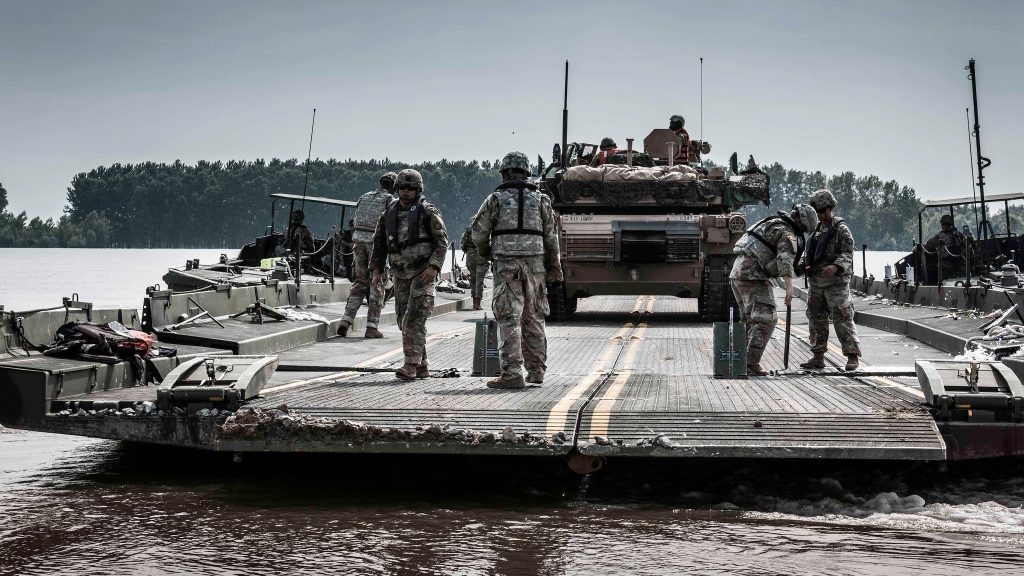 Photo: A US Army M1 Abrams tank is transported across the Danube River in Romania during Exercise Saber Guardian 2019. The exercise includes more than 8,000 soldiers from six NATO Allied and partner nations. It's co-led by Romanian Land Forces and US Army Europe. Credit: NATO
Photo: A US Army M1 Abrams tank is transported across the Danube River in Romania during Exercise Saber Guardian 2019. The exercise includes more than 8,000 soldiers from six NATO Allied and partner nations. It's co-led by Romanian Land Forces and US Army Europe. Credit: NATOThe 2016 Warsaw Summit allocated increased focus to the Black Sea. The communique not only outlined Russia’s aggressive actions in the region with more clarity (citing its large-scale snap exercises, military activities in the Black Sea to project power in the Mediterranean, military build-up in Crimea, and deployment of new high-end capabilities), but also began to identify areas where the alliance could or would act. Namely, Allied HOSG noted their support for Romania’s push to establish a multinational framework brigade to improve integrated training of Allied units at the Headquarters Multinational Division Southeast and to develop Georgia’s air defense and air surveillance. This is the first time that specific measures in the Black Sea region by a NATO ally and partner were highlighted.
Two years later at the Brussels Summit in 2018, NATO’s communique began to outline further areas of engagement in strengthening Black Sea security. These included reinforcing allied maritime posture, increasing NATO’s presence and activity in the Black Sea, and developing cooperation between the alliance and its partners: Georgia and Ukraine.
At the Brussels Summit in June 2021, the allies condemned Russia for its military build-up, calling for immediate reversal not just of the build-up but also of the blockade of Ukrainian ports and the Sea of Azov. Aside from general statements on cooperation with Ukraine on security in the Black Sea region and with Georgia on building resilience against hybrid threats, the summit communique made clear that the alliance increased its contributions to the tailored forward presence across all three domains. In all, there has been visible increase in attention paid to the Black Sea region in NATO’s outputs. 60
This attention led to action, even in the face of Russia’s spring 2021 initial force buildup along Ukraine’s borders. From June to July 2021, Standing NATO Maritime Group 2, numerous NATO members, and NATO partners were among 30 nations participating in Exercise SEA BREEZE 21, jointly hosted by Ukraine and the US Navy Sixth Fleet. 61 The period of Russia’s force buildup also saw increased ISR in the Black Sea region, including NATO Alliance Ground Surveillance (AGS), the Alliance-owned and operated remotely piloted aircraft. Of note, however, the commitment of NATO Battle Groups to Romania and Bulgaria (as well as Hungary and Slovakia) came about only after Russia’s invasion 2022 invasion of Ukraine. 62
NATO leaders met in Madrid four months after Russia’s third invasion of Ukraine. The Madrid Summit debuted a new Strategic Concept 63 and commitment to increased force readiness and posture. 64 The NATO 2022 Strategic Concept clearly states: “The Russian Federation is the most significant and direct threat to Allies’ security and to peace and stability in the Euro-Atlantic area.” The description of that threat goes on to say Russia’s “coercive military posture, rhetoric, and proven willingness to use force to pursue its political goals undermine the rules-based international order.” Further, Moscow’s military buildup, including in the Baltic, Black, and Mediterranean Sea regions, along with its military integration with Belarus, challenge the security and interests of the Alliance.
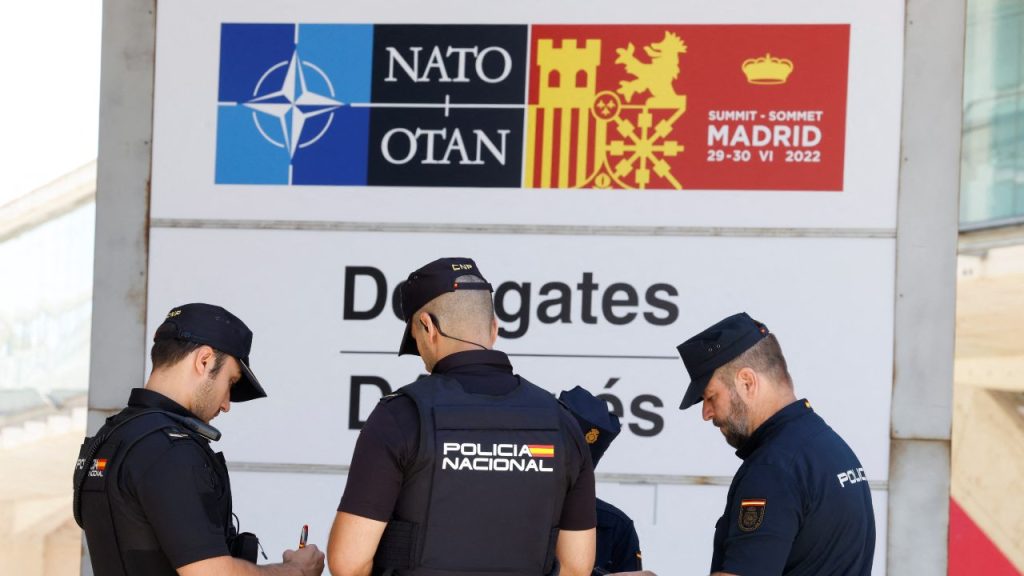 Photo: Police keep guard inside the Madrid Fair ahead of NATO Summit, in Madrid, Spain, June 27, 2022. Credit: REUTERS/Yves Herman
Photo: Police keep guard inside the Madrid Fair ahead of NATO Summit, in Madrid, Spain, June 27, 2022. Credit: REUTERS/Yves HermanNATO’s Strategic Concept clearly focuses on the strategic value of the Black Sea region. Allies make it clear that they will continue to support the Euro-Atlantic aspirations of interested countries in the region. They will also enhance efforts to bolster their capabilities to address the distinct threats and challenges they face and boost their resilience against malign third-party interference and coercion.
NATO’s Madrid commitments to enhance collective security could offer additional mileposts on the way ahead in the Black Sea region. 65 The Summit agreed to increase the NATO Response Force from 40,000 troops at high readiness to 300,000 across air, land, and sea domains. There was discussion about increasing eFP and tFP rotations to at least brigade size, but no specifics were outlined following the high-level discussions.
Recommendations for NATO's Security Strategy in the Black Sea Region
Given the invigorated guidance from the Madrid Summit, this report offers the following recommendations for NATO moving forward:Increase NATO Force presence since it is the key component of deterring further Russian aggression in the region. While regional leadership – finding common ground on which to engage all three Black Sea NATO members – is critical, commitment of forces to the region will require contributions from the other NATO member nations as well.
The most likely formula for increased NATO force presence in the Black Sea Region will be permanent bases and rotational forces. In April 2022, US Secretary of Defense Lloyd Austin and Chairman of the Joint Chiefs of Staff General Mark Milley recommended such a construct in testimony to Congress. 66
Military measures within a NATO Black Sea Security Strategy must be all-domain.Increase and sustain the rotational tFP. In February of 2022, NATO deployed multinational battle groups to both Romania and Bulgaria. 62 This response needs to codify a long-term commitment to rotating credible ground forces through the region.
Extend NATO’s commitment to the air policing mission in the region, including NATO E-3A Airborne Warning and Control (WACS) presence.
Increase rotational naval forces in the Black Sea, targeting a continuous 365-day presence.NATO naval presence in the Black Sea has limits on numbers, tonnage, and duration under the Montreux Convention. However, even with the increases made since 2014, allied Black Sea presence has not approached these limits.
NATO should maximize the presence of NATO naval formations – the Standing NATO Maritime Groups and the Standing NATO Mine Counter Measures Groups.
NATO member nations should commit to increased unilateral naval presence in the Black Sea, with strategic communications highlighting NATO themes, including for national missions.
NATO should increase the manning and capabilities of NATO headquarters structures in the region, such as the Multinational Division Southeast Headquarters and the Multinational Brigade.
NATO should establish a joint, multi-national three-star headquarters on the Black Sea. 67
Improve military mobility to and within the Black Sea Region.Undertake a comprehensive assessment of Bulgaria’s infrastructure network and its suitability for military mobility purposes.
Support improvements to Romanian and Bulgarian transit infrastructure.
Make better use of the Danube for bulk military cargo.
Exercise all of the above.
Prepositioned equipment, ammunition, and other supplies must be in place in the eastern European nations for rotations and deployed forces. Following the June 2022 NATO Defense Ministers meetings, NATO Secretary General Jens Stoltenberg specifically supported the pre-positioning saying it will be “much easier and faster to reinforce when needed.” 68
In addition to traditional force presence, NATO should increase ISR, specifically unmanned platforms, which can mitigate the anti-access area denial capabilities deployed in the BSR by Russia. ISR flights should be a high-profile part of any planned NATO increase of air forces. With many of these platforms featuring long endurance and long on-station times, ISR sorties can collect intelligence in international airspace over the Black Sea, or in Allied/partner sovereign airspace flying from bases outside the region. Unmanned aerial systems, either those of the member nations or of NATO’s own Allied Ground Surveillance RQ-4Ds, can also provide long-dwell-time sorties in international or Allied/partner airspace.Unmanned systems are not limited to airborne systems – unmanned surface and subsurface vessels can greatly build maritime domain awareness.
NATO’s strategy for the Black Sea Region should specifically commit to increased ISR, increased unmanned systems (air, surface, and subsurface). The Alliance should consider establishing an ISR / Regional Unmanned Systems Center of Excellence (CoE) or intelligence fusion center.
NATO exercises demonstrate commitment to the region’s security; increase interoperability among forces; provide valuable rehearsals for mobility, command, and control; and enhance the credibility of NATO deterrence. The table below depicts NATO exercises in the region since 2014. A commitment to increase exercises should be part of NATO strategy implementation.
NATO military activities in the Black Sea region must account for Russian hybrid actions in the region.
NATO’s strategy for the Black Sea must incorporate the non-ally partners in the region: Ukraine, Moldova, and Georgia. These nations already partner with NATO and enhancing those partnerships will contribute to regional security.
NATO should enhance outreach measures in the region, as segments of the populations within both ally and partner nations have a lingering hesitancy about NATO. NATO military presence, exercises, and activities should always incorporate well-planned and robust strategic communications. In addition, NATO should plan and implement measures to build connections to those segments of society. Academic exchanges, youth efforts, public-private partnerships, and other outreach measures should be key elements of a NATO strategy for the Black Sea region.
Economic security is key to the overall security of the region. Any strategy for the Black Sea Region must account for a comprehensive approach to economic security, including energy security, as well as partnering with the European Union and other international or regional organizations.
While most measures dedicated to economic security are outside traditional NATO roles, NATO must be prepared for military protection of energy infrastructure and military protection of food trade, including escort missions, within the region.
In addition to its long-standing practice of weaponizing energy trade 69 in the region, Russia has now proven to be effectively weaponizing food trade in the war in Ukraine as well. This severely affects global food supplies. 70 In addition to the effective blockade of Ukraine’s ports, Russia has conducted strikes on alternate overland routes. Multiple Russian attempts to target the Zatoka bridge (just 60 km outside of Odesa) over the Dniester Estuary reflects Russia’s interest in dominating the entire Ukrainian coast. On April 27, the Russian army fired rockets at the bridge twice, partially destroying it and limiting train routes in the region. 71 On June 1, the Russian army employed long-range missiles to strike and destroy the bridge. 72 The destruction of the bridge is of strategic importance. It can no longer be used for grain exports to Romania, a role it played following the blockade of the Ukrainian Black Sea ports. This also no longer allows for any ships to pass through. Clearly, Russia aims to cut Ukraine off from any connections to neighboring countries or to the sea. The aim to destroy and take control of strategic port cities is further exemplified by the multiple attacks on Odesa. These include the seven missiles fired on May 9 targeting civilian and tourist infrastructure, 73 and the three missiles that hit a housing block and killed 21 people on July 1. 74 While Putin has little chance of taking control of Odesa without moving from Kherson, taking Mykolaiv, and then moving further west to Odesa, he instead chooses to destroy infrastructure, kill civilians, and sow what he hopes would be fear and panic among the local population.
While most measures dedicated to economic security are outside traditional NATO roles, NATO must be prepared for military protection of energy infrastructure and military protection of food trade, including escort missions, within the region.
A United States Strategy for the Black Sea Region
On July 12, 2022, Senators Jeanne Shaheen (D-NH) and Mitt Romney (R-UT) introduced a bill for “the Black Sea Security Act of 2022.” This legislation would direct the executive branch to develop a strategy for the Black Sea Region that would: increase military assistance in coordination with NATO and the EU, deepen economic ties, strengthen economic and energy security and enhance security assistance, and support efforts in the region to bolster democratic resilience. 3 The bill includes guidance for specific elements within the strategy. 75 With regard to security, the US and NATO should increase presence and capabilities, increase coordination among Black Sea countries, prioritize ISR systems and air defense, and combat Russian disinformation and propaganda in the region. In the area of economic prosperity, the bill cites economic expansion and foreign direct investment designed to mitigate coercion by Russia and China, with specific emphasis on energy and food security. On democratic resilience, the legislation would require a strategy to increase independent media and US-supported media to combat foreign malign influence. The bill specifically references the Global Engagement Center and US Agency for International Development (USAID) to counter Russian propaganda and disinformation in the Black Sea region.
In June 2022, the US announced several moves to increase force posture in the region following the Madrid Summit. 76 These included adding two guided missile destroyers to the four homeported in Rota, Spain, committing a brigade-sized force to rotational deployments in Romania, and increasing US manning support to the Multinational Division HQ.
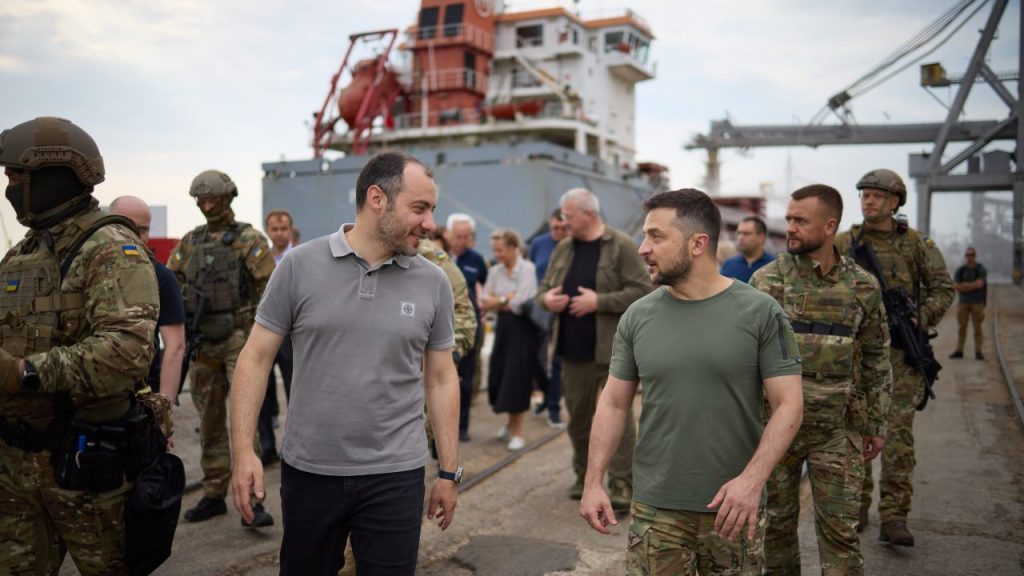 Photo: President Volodymyr Zelenskyy and aides visit the port of Odesa following the signing of a UN-backed deal to ensure the export of grain from Ukraine into the Black Sea. Credit: President of Ukraine's Office.
Photo: President Volodymyr Zelenskyy and aides visit the port of Odesa following the signing of a UN-backed deal to ensure the export of grain from Ukraine into the Black Sea. Credit: President of Ukraine's Office.The Shaheen-Romney bill is an excellent roadmap for the US to follow for the Black Sea region, and the US actions in support of greater NATO decisions at the Madrid Summit are a good start. In addition, and in greater detail, this report proposes the following recommendations for the US:
One key element of any US strategy for the region will be making the case on the importance of the region to the US public. The Russian war in Ukraine has perhaps mitigated the US blind spot over the Black Sea. However, a US national strategy for the Black Sea region must not fail to elucidate the US interests in the region:The Black Sea Region is a critical flank for NATO, and security in the Black Sea is vital to security in Europe.
With collective security commitments to three NATO allies in the region, effective deterrence and peace in the Black Sea directly benefits the United States.
The Black Sea Region is critically integrated in the global economy – specifically in the energy and food sectors.
US force deployments to the region must immediately address vulnerabilities of NATO members, including vulnerabilities exacerbated by direct supply of military equipment to Ukraine.Air defense and anti-drone capabilities are critical.
The current maritime security situation in the northwest Black Sea argues for near-term deployment of land-based anti-ship missile capabilities
US manning contributions to regional NATO efforts, such as the headquarters of the Multinational Division Southeast must incorporate a mindset of permanent change of station orders (PCS), rather than temporary duty (TDY).
In addition to US contributions under a NATO banner, the US can take specific bilateral actions with each of the three NATO Black Sea States. Measures that maximize their confidence in the US commitment to Black Sea security can only help optimize those nations’ regional leadership of NATO’s strategy and actions for Black Sea Regional Security.
Turkey must be central to any NATO security strategy for the Black Sea region. However, Ankara remains distrustful of the willingness of NATO and the US to fully back firm Turkish resistance to Russian moves short of an Article 5 situation. 77
The US should take the following bilateral actions with Turkey:Following the Madrid Summit, President Biden announced he would move forward with F-16 sales and F-16 modernization for Turkey. This decision on a capability and platform Turkey already operates – connected to the agreement for Turkey to move from opposing Finland’s and Sweden’s accession to NATO, but not a quid pro quo – will help alleviate the bilateral tensions that have been simmering since Turkey’s decision to purchase the S400 air defence system from Russia and the subsequent removal from F-35 program participation.
Past US support for Kurdish groups in Syria during the fight against Islamic State – specifically the YPG, which the US does not designate an international terrorist organization – remains a prominent concern for Turkey. The US could address this in some manner as well.
The US should take the following bilateral actions with Romania:Romania has existing contracts for Patriot missiles, but delivery has been delayed. The US should prioritize and expedite the delivery of this contract.
The US should speed approval of third-party Norway-Romania F-16 sales.
The US should expand consideration of Excess Defense Articles – there is a new request from Romania for Black Hawk helicopters previously intended for transfer to the Afghanistan National Army.
With significant US presence at Deveselu, Mihail Kogalniceanu, and Campia Turzii bases, consider transferring or deploying air defense systems.
The US should take the following bilateral actions with Bulgaria:Expedite delayed F-16 deliveries. These are third-party transfers from Norway, with approval processes currently being the holdup.
A US strategy for the Black Sea region should identify actions to support economic security in the region, including both energy security and food security. The recent provision of US liquefied natural gas (LNG) to Bulgaria to alleviate shortfalls after Russian cancellation of gas deliveries is one example of US unilateral actions for regional economic security.
Conclusion
Russia’s militarization of the Black Sea region over the course of the last decade or so led to an overall destabilization of the region. Moscow has become more confident employing coercion or force to achieve its strategic aims vis-a-vis the non-NATO countries in the region. These increased capabilities and confidence contributed to the Kremlin’s appetite to exert increased control over the region, leading to the decision in 2014 to annex Crimea and invade eastern Ukraine. While the US and NATO viewed these developments with concern, neither developed a coherent strategy for the security of the region. Six years later, Russia’s militarization has emboldened it to wage a full-scale invasion of Ukraine. The war – in its sixth month when this report goes to press – is as strong of a signal as any that the time is ripe for the US and NATO to develop comprehensive strategies and implementation plans for those strategies to deter further Russian aggression in the region and encourage the development of both NATO allied and partner nations in the Black Sea Region.
Methodology
This report examines how the Black Sea fits into the Kremlin’s strategic worldview and how Moscow has carried out its militarization of the region, leading up to its full-scale invasion of Ukraine. The research for this report draws on extensive consultations in the form of small group discussions and larger workshops with government officials, politicians, former diplomats, former military officers, analysts, experts, and others during the authors’ trips to Romania and Turkey in April 2022. Site visits to the Port of Constanța, the Mihail Kogalniceanu (MK) Air Base, and the Bosphorus Strait further enriched the authors’ understanding and analysis of Russia’s militarization strategy in the region and its possible implications for the US and the North Atlantic Treaty Organization (NATO). Consultations with the Embassy of Bulgaria to the United States in Washington, DC helped the report’s writers understand how all three NATO allies and littoral Black Sea states view the region. These consultations were complemented by virtual bimonthly discussions with an international network of Black Sea specialists.
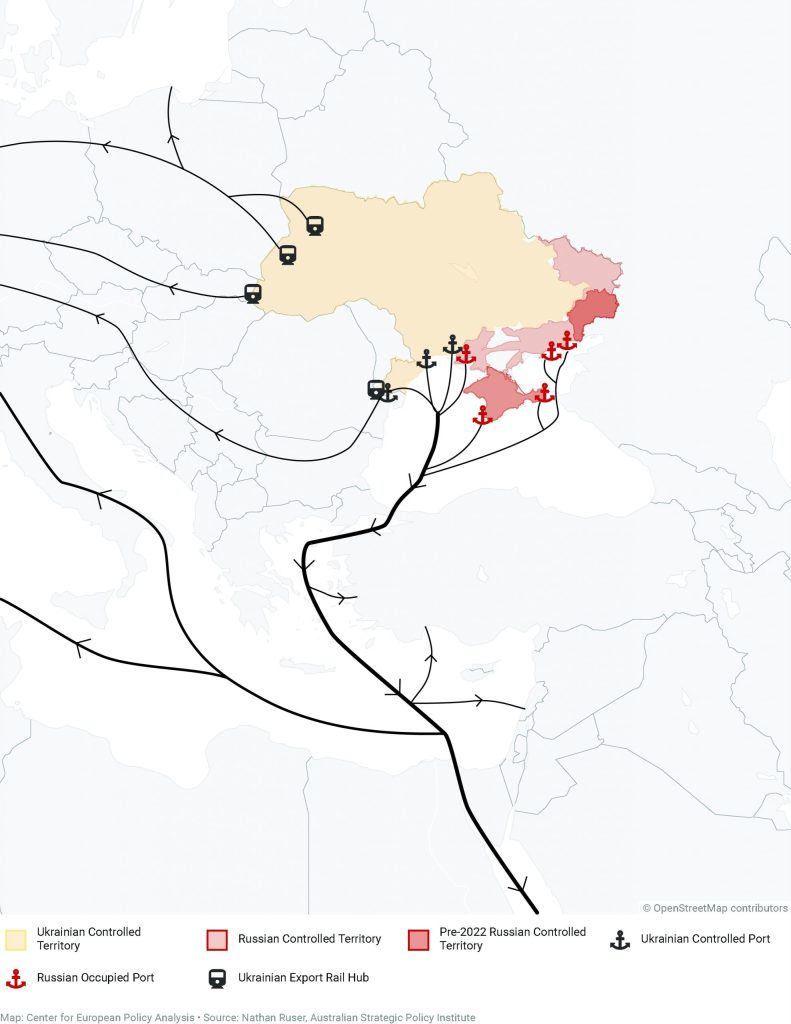
No comments:
Post a Comment